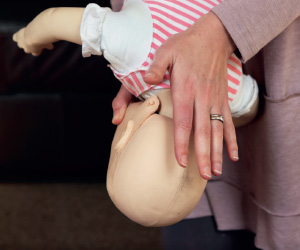Knowing what to do in an emergency can save your child’s life. By Ciska Thurman
First-aid kit
Start with ensuring you’re kitted out correctly – both at home and in your car. Pack the following supplies into a light, durable plastic toolbox. Label everything and ensure you regularly replace anything that has expired or been used up.
• A first-aid manual
• Sterile gauze
• Adhesive tape
• Ibuprofen syrup (with a measuring spoon and syringe)
• At least two triangular, elastic bandages for slings
• At least two crêpe or open-weave bandages to bind dressings and to support injured joints
• Two large and small sterile dressings
• One sterile eye dressing
• Four gauze pads as extra padding over a dressing
• One pack of sterile swabs
• A range of adhesive dressings or plasters
• Antiseptic wipes
• Antibiotic cream
• Antiseptic solution
• Hydrocortisone cream
• Rehydration powder
• Tweezers, a pair of sharp scissors and some safety pins
• Two disposable cold packs
• Burnshield
• Antihistamine cream
• Thermometer
• Plastic gloves
• Disposable resuscitator/mouth-to-mouth device
• List of emergency phone numbers (including nearest hospital, local police and fire stations)
• Your family’s medical information (including family doctor, medical aid number, allergies)
Safety checks at home
These checklists can prevent accidents from happening in your home. They are by no means exhaustive, but a good place to start:
Indoor safety
A fire-escape plan, with a working fire extinguisher on the premises.
Toddler gates installed at the top and bottom of all stairways.
Glass doors fitted with safety glass, and display stickers at children’s eye level.
Small and potentially hazardous items such as medication, matches, jewellery and batteries stored out of reach.
Safety latches or locks installed on cupboards containing dangerous or swallowable items.
All cleaning products and household poisons placed high up, locked away and out of sight (and in their original packaging, so they won’t be mistaken for anything else).
Outdoor safety
Garage doors and electric gates have safety mechanisms that disable the motor if there’s an obstacle.
All bodies of water – pool, pond, or water feature – covered with nets.
Pool enclosed by a 1.5m-high fence, with all gates latching and closing on their own.
No poisonous plants in your garden.
Playground equipment assembled and anchored correctly, over a level, cushioned surface.
When accidents happen
When your baby or child is injured or otherwise harmed in some way, the most important thing you can do is stay calm. Know who to call on what number and seek help immediately.
Always have your family’s basic health information at hand; the paramedics will need this.
Swallowed poison
Dos
• Assess what has been swallowed, when and how much.
• Call a poison centre to obtain immediate emergency advice.
• Remove any visible objects (pills, berries) from the child’s mouth.
Don’ts
• Don’t try and make them vomit (corrosive poisons will burn on the way back up).
• Don’t give them anything to drink (may spread the poison around the body even more quickly).
• Don’t allow your child to fall asleep if they are drowsy.
Burns and scalds
Dos
• Remove the source of the burn and cool by flushing with cool (not cold) water for 10–20 minutes.
• Cover with a sterile dressing or a clean plastic bag to prevent infection.
• Seek urgent medical attention if any smoke has been inhaled, the burn is bigger than the child’s palm or the burn was due to electric shock.
Don’ts
• Don’t apply cotton wool or a fluffy cloth that will stick to the burn.
• Don’t apply butter, lotion, petroleum jelly, ice, or anything besides a burn-relief dressing such as Burnshield.
• Don’t pop blisters, as they protect against infection and aid healing.
Choking
Baby
Kneel down and place baby face-down along your forearm. Allow your forearm to rest against your thigh, so that the baby’s head is lower than his body, and his face is supported in the palm of your hand. Slap him firmly up to five times between the shoulder blades.
Toddler or child
If the child is too big to safely get the head lower than the chest, then stand behind her and wrap your arms around her waist so that your fist rests against her tummy just above the navel, but below the ribs. Grasp your fist with your other hand and give five quick inward and upward thrusts.
Important!
These anti-choking measures are for partially blocked airways. If the child stops breathing, you may have to administer CPR. This is a life-saving skill that can only be taught by a professional and needs to be practised often. Sign up for a first-aid and CPR course today, if you have not yet attended one.
Medical Advice line
Club members have access to reliable medical advice, 24 hours per day, as well as free 24-hour access to emergency services. Contact 0861 424 789 (subscribers outside SA, dial +27 11 991 8330).








